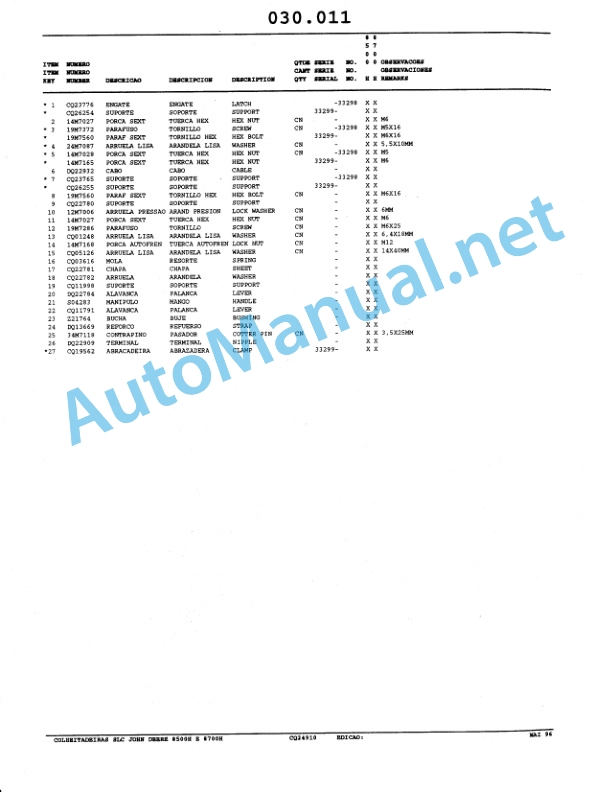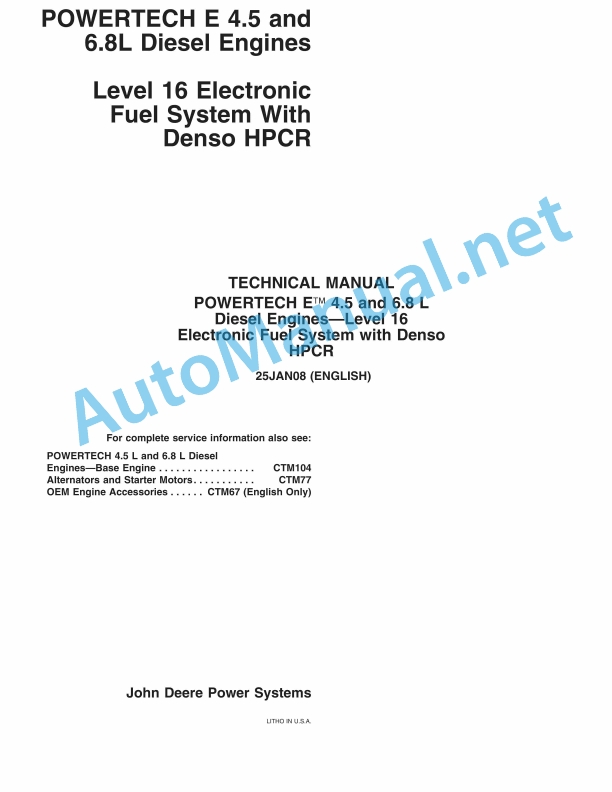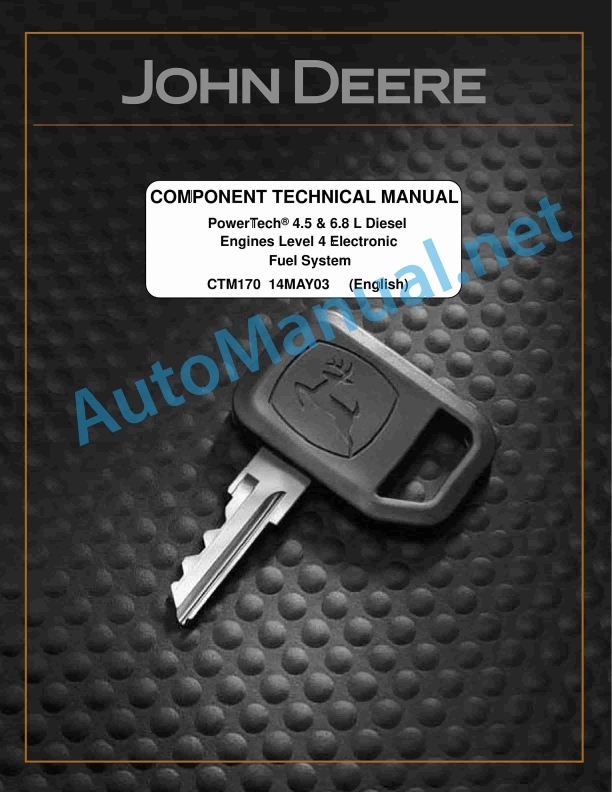Claas Rollant 350 Rc (762) Baler Operator Manual ES
$50.00
- Model: Rollant 350 Rc (762) Baler
- Type Of Manual: Operator Manual
- Language: ES
- Format: PDF(s)
- Size: 41.4 MB
File List:
00 0301 244 1.pdf
00 0301 244 1.pdf:
ROLLANT 340ROLLANT 350ROLLANT 340 RotoCutROLLANT 350 RotoCut
1. Introduction
1.1 General information
1.1.1 Application of this user manual
1.1.2 Information relating to this instruction manual
1.1.3 Symbols and indications
1.1.4 Optional equipment
1.1.5 Qualified specialized workshop
1.1.6 Maintenance instructions
1.1.7 Information regarding warranty
1.1.8 Spare parts and technical questions
1.2 Proper application of the machine
1.2.1 Authorized use
1.2.2 Reasonably foreseeable misuse
2 Security
2.1 Recognize warning signs
2.1.1 Danger symbols
2.1.2 Keyword
2.2 Safety instructions
2.2.1 Meaning of the instruction manual
2.2.2 Observe graphic danger symbols and alarm indications
2.2.3 Requirements for all people working with the machine
2.2.4 Children in danger
2.2.5 Danger zones
2.2.6 Position yourself between the tractor and the machine
2.2.7 Accompanying persons
2.2.8 Couple the tractor with the machine
2.2.9 Risk of injury due to rotating shafts
2.2.10 Construction changes
2.2.11 Optional equipment and spare parts
2.2.12 Control of the tractor in operation
2.2.13 Use only after correct start-up
2.2.14 Technical status
2.2.15 Danger due to machine breakdowns
2.2.16 Comply with technical limit values
2.2.17 Danger due to coasting parts
2.2.18 Keep protective devices operational
2.2.19 Personal protective equipment
2.2.20 Wear appropriate clothing
2.2.21 Remove dirt and loose objects
2.2.22 Prepare the machine for road traffic
2.2.23 Dangers when driving on the road and in the countryside
2.2.24 Park the machine safely
2.2.25 Parking without supervision
2.2.26 Unsuitable consumables
2.2.27 Safe handling of consumables and auxiliary materials
2.2.28 Environmental protection and waste disposal
2.2.29 Fire protection
2.2.30 Very dangerous electrical discharge from overhead power lines
2.2.31 Electrical shock from electrical equipment
2.2.32 Liquids under pressure
2.2.33 Pressurized air
2.2.34 Hot surfaces
2.2.35 Work only on the stopped machine
2.2.36 Maintenance work and repair work
2.2.37 Machine parts and lifted loads
2.2.38 Risks derived from welding work
2.3 Graphic danger symbols
2.3.1 Structure of graphic hazard symbols
2.3.2 Location of safety stickers
2.3.3 Location of safety stickers
3 Machine Description
3.1 Existing models
3.1.1 Designation of machines
3.2 Overview and functions
3.2.1 Left side
3.2.2 Right side
3.2.3 Identification of the rollers
3.3 Safety equipment
3.3.1 Signal lighting
3.3.2 Reflective equipment
3.3.3 Surety
3.3.4 Chocks
3.3.5 Holding cable*
3.3.6 Tailgate lock
3.3.7 Locking the pick-up
3.3.8 Fire extinguisher
3.4 Work and service positions
3.4.1 General information
3.4.2 Front of the baler
3.5 Identification plate and serial number
3.5.1 Spare parts and technical information
3.5.2 Serial number
3.5.3 Identification plate
3.5.4 Axle identification plate
3.5.5 Rudder identification plate*
3.6 General operating principle
3.6.1 Bale pressing cycle
3.7 Control terminal
3.7.1 Control terminal
3.7.2 ISOBUS connection
3.8 Trailer support
3.8.1 Types of fixing
3.9 Transmission and drive
3.9.1 Power transmission
3.9.2 Main drive
3.9.3 Carrier drive (optional)
3.9.4 Pick-up drive
3.9.5 Drive Chains
3.9.6 Rotor drive (optional)
3.10 Harvest harvest
3.10.1 Pick-up
3.10.2 Compactor
3.10.3 Short straw plank (optional)
3.11 Power supply unit
3.11.1 Carrier (optional)
3.11.2 Rotor (optional)
3.11.3 RotoCut cutting device (optional)
3.11.4 Manual rotor reversal*
3.11.5 Hydraulic rotor reversal*
3.12 Pressing system
3.12.1 Pressing chamber and rollers
3.12.2 Pressing cycle
3.13 Tying system
3.13.1 Tying categories and types
3.13.2 Standard tying
3.13.3 Tying adjustment
3.13.4 Thread compartment (depending on equipment)
3.13.5 Mesh reserve (depending on equipment)
3.13.6 Mesh compartment (depending on equipment)
3.14 Unloading bales
3.14.1 Bale unloading ramp
Use without bale unloading ramp
3.15 Lubrication system (oil)
3.15.1 Automatic chain lubrication
3.16 Hydraulic system
3.16.1 Baler Hydraulic Block
3.17 Equipment
3.17.1 Ladder (Depending on equipment)
3.17.2 Stirrup
3.17.3 Pressure gauge
3.17.4 Mechanical bale counter
3.17.5 Electronic module
4 Control and display instruments
4.1 CLAAS STANDARD TERMINAL
4.1.1 Presentation
4.1.2 Key identification
4.1.3 Presentation of visualizations
4.2 OPERATOR
4.2.1 Presentation
4.2.2 Description of the OPERATOR menus
4.3 ISOBUS Terminal
4.3.1 Presentation
5 Technical data
5.1 Baler
5.1.1 Dimensions
5.1.2 Weight
5.1.3 Hookup
5.1.4 Cardan shaft
5.1.5 Feeding and pressing
5.1.6 Tying device
5.1.7 Wheels
5.1.8 Hydraulic circuit
5.1.9 Screw tightening torques
5.1.10 Greasing and lubrication
5.1.11 Sound levels
5.2 Safety devices
5.2.1 Security screw
5.2.2 Torque limiter
5.3 Inputs
5.3.1 Lubricants
5.4 Tractor
5.4.1 Required power
5.4.2 Authorized mass of the towing vehicle – TÜV approval*
5.4.3 Hooking
5.4.4 PTO
5.4.5 Electrical connections
5.4.6 Hydraulic connections
5.4.7 Hydraulic circuit and oil
6 Preparation of the machine
6.1 Turn off the machine and secure it
6.1.1 Stop and secure the tractor and machine
6.2 Adapt the tractor
6.2.1 Check the tractor power take-off protection device
6.2.2 Adapt the tractor’s pneumatic brake equipment
6.2.3 Mount OPERATOR*
6.2.4 Battery cable*
6.3 Adapt the machine
6.3.1 Recommendations
6.3.2 Adaptation of the fork hitch / swing bar hitch
6.3.3 Cardan shaft coupling
6.3.4 Adaptation of the cardan shaft length
.3.5 Transformation kit, 8 grooves*
6.4 Hooking up the machine
6.4.1 Holding cable*
6.4.2 Cardan shaft safety regulations
6.4.3 Positioning the cardan shaft
6.4.4 Marking of hydraulic hoses
6.4.5 Connection to the tractor’s double-acting distributor
6.4.6 Identification of electrical cables
6.4.7 Lighting
6.4.8 Power supply to the baler and CLAAS Standard Terminal
6.4.9 Power supply to the baler and OPERATOR*
6.4.10 Baler power supply with ISOBUS cable
6.5 Prepare for use at work
6.5.1 Pick-up wheels
6.5.2 Pick-up height
6.5.3 Compactor
6.6 General information
6.6.1 First commissioning
6.6.2 Equipment control
6.7 Tying with thread
6.7.1 Yarn quality
6.7.2 Preparation
6.7.3 Thread tensioner adjustment
6.7.4 Positioning the side thread stop
6.7.5 Thread placement
6.7.6 Selection of tying with standard twine*
6.8 Tying with mesh
6.8.1 Preparation
6.8.2 Mesh placement
6.8.3 Mesh roll brake adjustment
6.8.4 Selection of tying with standard mesh*
6.9 Unloading bales
6.9.1 Assembly of the bale unloading ramp
6.9.2 Presetting of the bale unloading ramp
6.9.3 Bale unloading without bale unloading ramp (optional)
6.10 Pressing chamber
6.10.1 Bale start stops
6.10.2 MPS adjustment
6.11 Cutting device
6.11.1 Safety regulations
6.11.2 Control
6.11.3 Placing the blades
6.11.4 Placing the false blades*
6.11.5 Unused blades and dummy blades
6.12 Load the machine
6.12.1 Baler stowage
6.12.2 Lifting points
6.12.3 Elevation
7 Management
7.1 General information
7.1.1 Baler user
7.1.2 Side doors
7.2 Movements with the baler
7.2.1 Equipment control
7.2.2 Preparations for transportation
7.2.3 Road travel
7.2.4 Arrival at the field
7.2.5 Moving around the field
7.2.6 Parking
7.3 Before each use
7.3.1 Reminders
7.3.2 Cardan shaft
7.3.3 Baler maintenance
7.4 Commissioning in the field
7.4.1 Usage tips
7.4.2 Commissioning of the machine
7.5 Pick-up
7.5.1 Important
7.6 Tied
7.6.1 Selection of tying with thread or mesh*
7.6.2 Setting the number of thread turns
7.6.3 Adjustment of the number of mesh turns
7.6.4 Changing the mesh roll
7.7 Bale parameters
7.7.1 Bale adjustments
7.8 CLAAS STANDARD TERMINAL
7.8.1 Tying type selection*
7.8.2 Setting the Twine Tying Time
7.8.3 Net Tying Time Adjustment
7.8.4 Pressing-tying process
Particular case
Use without bale unloading ramp
7.8.5 Manual activation of the tying process
7.8.6 Manual delay of the tying process
7.8.7 RotoCut* cutting device
7.8.8 Faults
7.9 OPERATOR
7.9.1 Counters Menu
7.9.2 Setting bale parameters
Tying time
Setting tying times
Tying type selection
7.9.3 Pressing-tying process
7.9.4 Manual activation of the tying process
7.9.5 Manual delay of the tying process
7.9.6 RotoCut with fixed rotor bottom*
7.9.7 Faults
7.10 ISOBUS Terminal
7.10.1 General information
7.11 Unclogging the baler
7.11.1 How to avoid traffic jams?
7.11.2 Safety regulations
7.11.3 Unclogging the pick-up
7.11.4 Unclogging the carrier
7.11.5 Unclogging the rotor*
7.12 After use
7.12.1 Reminders
7.12.2 Securing the baler
7.12.3 Daily checks
7.12.4 Daily cleaning
7.12.5 Baler release
8 Incident and solution
8.1 General information
8.1.1 Sensors
8.2 CLAAS STANDARD TERMINAL
8.2.1 General information
8.2.2 Closing the tailgate
8.2.3 Unloading bales
8.2.4 Tying with thread
8.3 OPERATOR
8.3.1 Unloading the bale
8.3.2 Tying with thread*
8.4 ISOBUS terminal
8.4.1 General information
8.4.2 Unloading the bale
8.4.3 Tying with thread*
8.5 Tying system
8.5.1 Origin of problems
8.5.2 Tying with thread
8.5.3 Tying with mesh
8.6 Lubrication system
8.6.1 Origin of problems
8.6.2 Troubleshooting
9 Maintenance
9.1 General maintenance instructions
9.1.1 Maintenance and safety tips
9.1.2 Wheels and tires
9.1.3 Brakes
9.1.4 Hydraulic circuit
9.1.5 V-belt
9.1.6 Chains
9.1.7 Cardan shaft
9.1.8 Protection devices
9.1.9 Inductive sensors
9.2 Maintenance tables
9.2.1 Maintenance operations before harvest
9.2.2 Maintenance operations after the first 10 hours of service
9.2.3 Maintenance operations after the first 50 hours of service
9.2.4 Maintenance operations every 8 hours of service or every day
9.2.5 Maintenance operations every 50 hours of service
9.2.6 Maintenance operations every 100 hours of service
9.2.7 Maintenance operations every 250 hours of service
9.2.8 Annual maintenance operations or every 500 hours of service
9.2.9 Maintenance operations if necessary
9.3 Greasing scheme
9.3.1 Greasing
9.3.2 Cardan shaft
9.3.3 Greasing points – 8 h
9.3.4 Grease points – 50 h
9.3.5 Greasing points – 100 h
9.4 Gear maintenance operations
9.4.1 Drive box 540 rpm
9.4.2 Cardan shaft security screw
Replacing the screw
9.5 Axle and wheel maintenance operations
9.5.1 Tire check
9.5.2 Checking wheel tightening
9.5.3 Replacing the wheels
9.5.4 Wheel hub
9.6 Hitch device maintenance operations
9.6.1 Fixing the hitch hole and rudder
9.7 Hydraulic system maintenance operations
9.7.1 Filter
9.8 Pick-up maintenance operations
9.8.1 Pick-up drive chains
9.8.2 Pick-up security screw
9.8.3 Pick-up tensioner
9.9 Maintenance operations on the power supply unit
9.9.1 Carrier drive spring (optional)
9.9.2 Rotor drive spring (optional)
9.9.3 Adjusting the height of the blades (RotoCut Machines)
9.9.4 Rotor reversing device security screw (optional)
9.10 Pressing chamber maintenance operations
9.10.1 MPS springs (oscillating segment)
9.10.2 Roller drive springs
9.10.3 Cleaning the roller
9.11 Tying maintenance operations
9.11.1 Tying with thread
9.11.2 Tying with mesh
9.12 Bale unloading maintenance operations
9.12.1 Bale unloading ramp
9.13 Lubrication system maintenance operations
9.13.1 Chain lubrication
9.14 Maintenance operations of the lubrication system
9.14.1 Manual lubrication
9.15 Bodywork maintenance operations
9.15.1 Fire extinguisher (optional)
9.16 Hibernation
9.16.1 General information
9.16.2 Cleaning
9.16.3 Cleaning surfaces with stickers
9.16.4 Greasing
9.16.5 Maintenance
9.16.6 Storage
10 Decommissioning and waste disposal
10.1 General information
10.1.1 Decommissioning and waste disposal
11 EC declaration of conformity
11.1 General information
11.1.1 Declaration of conformity for CE
11.1.2 Declaration of conformity for CE
John Deere Repair Technical Manual PDF
John Deere 18-Speed PST Repair Manual Component Technical Manual CTM168 10DEC07
John Deere Parts Catalog PDF
John Deere Harvesters 8500 and 8700 Parts Catalog CPCQ24910 Spanish
John Deere Repair Technical Manual PDF
John Deere PowerTech M 10.5 L and 12.5 L Diesel Engines COMPONENT TECHNICAL MANUAL CTM100 10MAY11
John Deere Repair Technical Manual PDF
John Deere Repair Technical Manual PDF
John Deere POWERTECH E 4.5 and 6.8 L Diesel Engines TECHNICAL MANUAL 25JAN08
John Deere Repair Technical Manual PDF
John Deere Repair Technical Manual PDF
John Deere Repair Technical Manual PDF
John Deere DF Series 150 and 250 Transmissions (ANALOG) Component Technical Manual CTM147 05JUN98





















